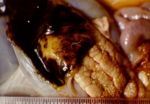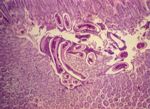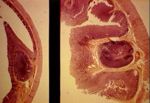Difference between revisions of "Enteritis, Parasitic"
Jump to navigation
Jump to search
| (3 intermediate revisions by 2 users not shown) | |||
| Line 8: | Line 8: | ||
** Especially in Australia. | ** Especially in Australia. | ||
** e.g. [[Nematodirus|''Nematodirus'']] and [[Trichuris|''Trichuris'']]. | ** e.g. [[Nematodirus|''Nematodirus'']] and [[Trichuris|''Trichuris'']]. | ||
| − | * A pre-patent period of 7-10 days is followed by the development of greenish [[Diarrhoea|diarrhoea]]. | + | * A pre-patent period of 7-10 days is followed by the development of greenish [[Intestine Diarrhoea - Pathology|diarrhoea]]. |
** The gut becomes filled with greenish soupy material. | ** The gut becomes filled with greenish soupy material. | ||
** Oedema and hyperaemia of mucosa occurs. | ** Oedema and hyperaemia of mucosa occurs. | ||
| Line 15: | Line 15: | ||
[[Category:Enteritis, Catarrhal]] | [[Category:Enteritis, Catarrhal]] | ||
[[Category:Enteritis,_Parasitic]] | [[Category:Enteritis,_Parasitic]] | ||
| − | |||
Revision as of 14:27, 1 June 2010
- This is the most important condition causing cattarhal enteritis worldwide.
- Seen mainly in grazing animals.
- Especially in sheep - causes large production losses.
- Particularly problematic since some parasites are resistant to anthelmintics.
- Especially in Australia.
- e.g. Nematodirus and Trichuris.
- A pre-patent period of 7-10 days is followed by the development of greenish diarrhoea.
- The gut becomes filled with greenish soupy material.
- Oedema and hyperaemia of mucosa occurs.
- In young animals, parasites can cause serious disease and even death.


